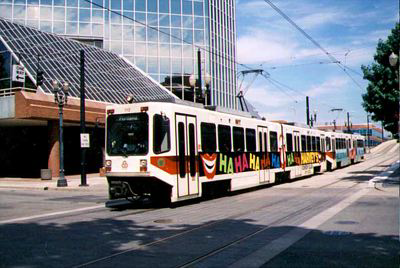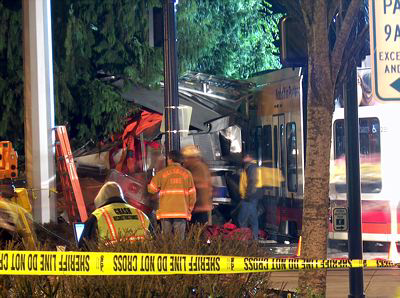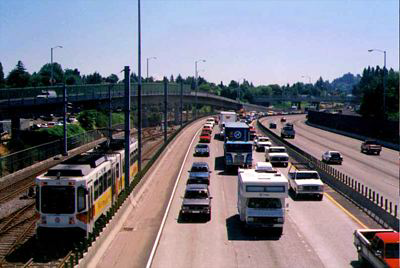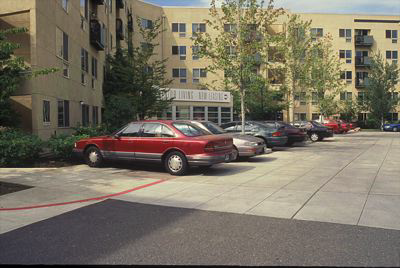No Light Rail in Vancouver!
TriMet Responds to “Debunking Portland”

TriMet, Portland’s transit agency, has posted on its web site a response to the Antiplanner’s article, Debunking Portland. The response makes six points:
1. Light rail is “a well-
2. Portlanders love light rail.
3. Light rail is cheap.
4. Light rail is fast.
5. Light rail “translates into more density, less parking, and new mixes of commercial and residential development.”
6. Light rail is a great investment in the future.

The laugh is on the taxpayers who had to shell out $1.65 billion, and rising, to
build Portland’s light-
Here are the Antiplanner’s replies.
1. What was the historical justification for light rail?
“Mr. O’Toole asserts that the Portland region is spending too much on public transit,
diverting funds from other community needs,” says TriMet, which then proceeds to
say nothing at all about this question. Instead, it summarizes the glorious history
of how Portland stopped an evil freeway from cutting through a neighborhood, built
bike and pedestrian facilities, promoted a “compact urban form” with an urban-
Just what does any of that have to do with light rail? Only this: as my Cato paper points out, Congress allowed Portland to spend the federal dollars that would have been used for the cancelled freeway on transit instead — but only for capital improvements. TriMet didn’t have enough revenue to operate all the buses it could have purchased with that money. So it decided to build light rail — precisely because it was expensive and could use up all of those federal funds.
Subsequent light-
As far as the urban-
2. Do Portlanders love light rail?
Even though Portlanders voted against spending any more money on light rail in 1998, TriMet argues that “Portland residents vote every day for light rail at the farebox.” Just what do these votes register?
According to data published by the US DOT (and supplied to it by TriMet and the Oregon
Department of Transportation), light rail carries less than 1 percent of all passenger
travel in the Portland area. The 2000 census found that 6.3 percent of Portland-
Those Portlanders who do vote at the farebox are not “voting” very much. TriMet reports
an average fares per light-
TriMet points out that transit ridership increased by 53% between 1995 and 2005, which, it argues, “is outpacing the 25% growth in vehicle miles of travel.” Actually, according to the US DOT’s Highway Statistics, Portland driving increased by 51 percent during that time period.
But the growth relative to driving is pretty irrelevant because, as they say, twice nothing is still nothing. Transit has such a tiny share of Portland’s travel that, even if it were growing by 2 percent per year and driving by only 1 percent per year, it would take over 160 years for transit to reach even 10 percent of total passenger travel.
3. How costly is light rail?
Even though light rail costs a lot to build, TriMet argues that the savings in operating costs will make up for it. It costs $2.66 per ride to operate buses, says TriMet, but only $1.48 for light rail.
Of course, TriMet is comparing apples and oranges when it compares the cost of operating
all its buses with the cost of light rail. TriMet built its light-
TriMet’s light-
TriMet does say that the cost of “the most productive 16 Frequent Service bus routes”
is $2.14 per ride, or 66 cents more per ride than light rail. At that rate, it will
only take 2.5 billion rides to cover the $1.65 billion spent building the light-
Of course, ridership will probably grow. But, let’s amortize that $1.65 billion at
5-
TriMet trots out the hoary old claim that it built “every project . . . on or ahead
of schedule and within budget.” Yes, provided you look at the last schedules and
budgets. But TriMet’s first light-
TriMet further argues, “Rarely do funds for the construction and operation of light rail compete with core community needs.” This is only true if “rare” means “nearly all.” TriMet provides a table showing that the region has spent $1.65 billion on light rail, of which $512 million came from local funds and the rest from federal funds — meaning gas taxes and other highway user fees.
Virtually all of the local funds could have been spent on “core community needs”
(including just leaving the money in taxpayers’ pockets). TriMet is even resorting
to tax-
All of the federal funds could have been spent on bus transit and a large share — possibly a majority — could have been spent on roads. Of course, if Congress had not been persuaded to divert gas taxes into transit, it all would have been available for roads.
In short: light rail cost far more than buses, and virtually all of that additional cost cuts into funds that could have been spent on a variety of other local needs.
4. Is light rail fast?
TriMet admits that Portland’s light rail averages just 19.3 miles per hour. But then
it claims that this is fast because “light rail does not have to contend with delays
due to accidents and congestion.” Actually, it does have to contend with delays due
to accidents, as when rail cars run into automobiles or pedestrians. And then there
are the delays due to crime taking place on the light rail or at light-

Never suffers delays due to accidents? Tell that to the city of Hillsboro, whose
brand-
Even 19.3 miles per hour overstates light rail’s speed because cars provide door-

If light rail doesn’t have to face congestion, why are all these people driving cars?
Because they know that, though they may be stuck in traffic now, they are likely
to get to their destinations faster than the people on the 19.3-
Plus it is cheeky of TriMet to pan auto congestion when much of that congestion is
due to the fact that Portland has diverted highway funds into light rail. Recall
Andy Cotugno, Metro’s transportation planner, saying that Portland was deliberately
letting congestion on roads in light-
5. Does light rail promote new development?
Intriguingly, TriMet admits that “light rail does not by itself promise redevelopment,” but because light rail provides “clean, quiet access” it allows development that is more “pedestrian oriented.”
These are all fine words, but the bottom line is that no transit-
“The City of Portland has used tax incentives to help overcome redevelopment hurdles,”
says TriMet, “but recently recognized that the transit-
But TriMet ignores the $1.2 billion in tax-

This development offers less parking than normal — so these cars are parked on the sidewalk. Photo by John Charles.
“These developments generally require less parking,” says TriMet. Says who? Many
of the developments with limited parking are bankrupt, have high vacancies, or survive
only because people illegally park in firelanes and on sidewalks. Interestingly,
Portland just approved a $6.6 million subsidy for a parking garage for one of these
so-
TriMet never mentions the fact that most of the people living in these developments still drive for most of their trips. Sure, a few people may be living without cars, but they could just as easily live without cars if TriMet offered excellent bus service.

When Fred Meyer renovated this store, TriMet counted it as an investment stimulated
by light rail (note the train in the background). In fact, Fred Meyer renovated all
of its stores at around that time. But shortly after this photo was taken, Fred Meyer
permanently closed this store due to high crime. Do you think light rail could have
stimulated that? When residents of this neighborhood put extra locks on their doors
to foil rail-
“Light rail and streetcar investment has been matched with more than $8 billion in adjacent new development,” claims TriMet. This number includes the cost of every new development that happens to be near the rail lines, whether or not they are transit oriented, whether or not they received other subsidies, and whether or not they have anything to do with the rail lines.
Much of the $8 billion is government buildings in downtown Portland. Some of it is downtown parking garages (like the one mentioned above). Almost none of it was clearly inspired by the rail lines.
In short, rail transit has generated no new development in Portland. All it has generated is more subsidies to development.
6. What are the long-
Portland “has saved billions of dollars in infrastructure costs.” Excuse me, how
does a $1.6 billion transit system that carries 0.9 percent of travel save billions
in infrastructure costs? The average Portland light-
TriMet cites questionable claims that the region’s compact development has reduced
per-
Conclusions
Light rail costs a huge amount of money. Whether it saves any money in operating
costs is questionable, but even if it does, that savings will never repay the up-
Light rail hasn’t clearly generated any new development, and the high-
Light rail is a part of a social-
Light rail produces benefits only to the companies that design and build it and to the bureaucracy that runs it, which gets much larger budgets and the prestige that goes with those budgets. So it is not surprising that TriMet would defend it. But in view of the facts laid out in the Cato paper, that defense fails to justify the billions the region has spent on rail transit.
6
Trackback • Posted in Follow up, Transportation
Reprinted from The Antiplanner